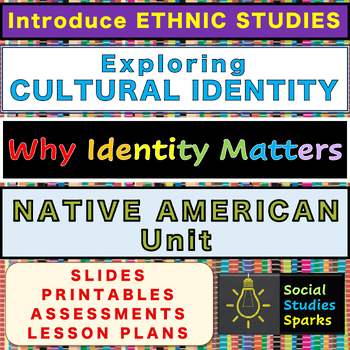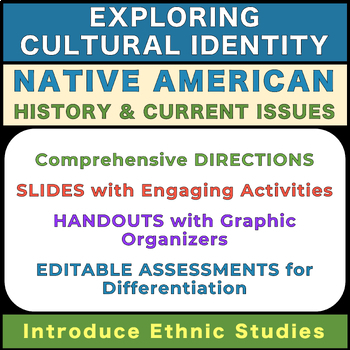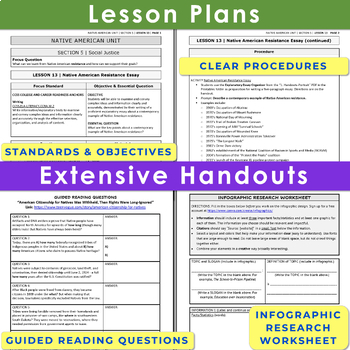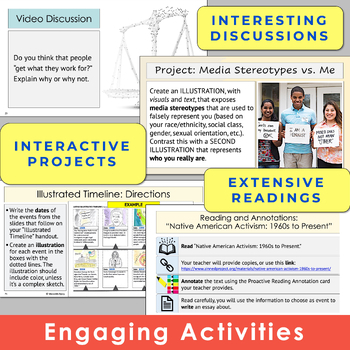Cultural Identity and Native American Units - Ethnic Studies Introduction & more
- Zip
- Easel Activity
- Easel Assessment
Products in this Bundle (3)
Bonus
Description
Introduce terms with Explore Cultural Identity. Delve deeper into concepts with Why Identity Matters. Apply this foundation to an in-depth unit with Native Americans: History and Current Issues. LOW PREP (print and go) — includes lesson plans, slides with engaging activities, PDF handouts, plus formative and summative assessments. Use for Ethnic Studies and History, provide context for English topics. High School resource that could be used advanced 8th graders and work for digital learning.
“Who am I?” Students love to explore this question. In Exploring Cultural Identity, they examine different facets of identity. Lessons clarify terms that can be confusing. Explain the difference between race, ethnicity and nationality, and between sex, gender and sexual orientation.
In Why Identity Matters, deepen student’s understanding of cultural identity. Delve into concepts such as social construction, socialization, prejudice, discrimination, power, meritocracy, systemic oppression, inequality, intersectionality, media stereotypes, and social justice. Need a last minute or substitute lesson? No prep option—students can participate in engaging activities using directions on the slides, links, and their own paper, or you can use the handouts.
The Native American unit provides an overview of socio-political history with an emphasis on 20th century issues. (It does not focus on individual tribal nations.) Intensive prep has been done so that you can focus on teaching! The lessons help you address complex issues with sensitivity and respect.
Teacher directions include differentiation strategies to help meet individual student needs. Student directions are clear and concise, and the lessons include numerous graphic organizers that provide scaffolding. The multiple-choice test is editable so assessments can be differentiated, as are the slide text boxes that have definitions, explanations, and questions. There are even slide templates so you can customize the lessons!
*For copyright reasons, other materials in this resource are NOT editable (the editable components are listed above).*
The EXPLORING CULTURAL IDENTITY resource includes:
- A Guide with easy, step-by-step directions
- A PowerPoint with 50 slides that explains 12 facets of cultural identity and provides ample opportunity for discussions
- A handout of terms and definitions, including culture, subculture, nationality, race, ethnicity, class, sex, gender, sexual orientation, and religion
- A matching quiz and a fill-in-the-blank quiz (with keys) in PDF and a multiple-choice quiz in Easel
- Links to engaging and informative short videos
- A Close Watching: Video Response Notes handout
- Close Reading Annotations cards for a reading on “Creating a Latino Race"
- A reading and questions on “Why Identity Matters”
- A reflection in which students identify aspects of their own identity, rank their importance, and discuss their influence in both PDF and Easel versions
The WHY IDENTITY MATTERS resource includes:
- A PowerPoint with 45 slides
- Directions in the slide notes
- A Close Watching: Video Response Notes handout
- A “Media Stereotypes vs. Me” project with a rubric
- Close Reading Annotation cards for a reading and questions on “Why Identity Matters”
The NATIVE AMERICANS: HISTORY AND CURRENT ISSUES unit includes:
- An overview that includes information about addressing sensitive topics
- 14 PDF lesson plans with objectives, essential questions, standards, and differentiation
- Lesson plans also include easy, step-by-step, procedures
- 124 PowerPoint slides with multiple activities and 9 slide templates so you can customize the resource
- Lesson plan procedures are also in the slide notes
- 40 pages of PDF handouts with clear directions, including:
- A Note-Taker for terms and definitions with a key
- A Draw It! activity on four key terms
- A multiple-choice test (with a key) in editable Word, and Easel versions
- A Close Watching: Video Response Notes handout
- Close Reading Annotation cards
- Reading and questions on multiple topics including federal policies, current issues, and activism
- A living timeline activity with 24 Native American history events cards
- An illustrated timeline activity on 28 Native American history events with accompanying slides
- Guided Reading Questions (with a key) on a text about American citizenship for Native Americans
- An infographic activity (with a rubric) about Native American current issues
- An explanatory essay organizer for a five-paragraph activity about Native American resistance
- A mini-debate activity (with a rubric) about materialism
- A reflection in which students write about the most important things that they learned
- Optional suggestions for readings and activities from A Different Mirror for Young People by Ronald Takaki
The unit includes these primary concepts that are taught in the context of the time period in which they occurred: Paleo-Americans, Beringia, Native Americans, indigenous, tribe, nation, country or state, sovereignty, treaty, removal, reservation, assimilation, allotment, re-organization, termination, relocation, self-determination, and self-government.
The Native American unit teaching duration is five to eight weeks if every lesson is used. The variation in the length of the unit is mainly due to the option of doing assignments as classwork or homework. I have made the Ethnic Studies units thorough and extensive in order to meet diverse needs. You may need to pick and choose lessons to fit within your time frame.
BONUS: An editable Ethnic Studies Syllabus and Pacing Planner is included!
IMPORTANT NOTES
- The LGBTQ+ introductory unit provides an introduction to the same terms as Exploring Cultural Identity (included here). I SUGGEST USING ONE OR THE OTHER (NOT BOTH).
- While teaching online during the pandemic, I began to utilize short video clips for instruction. They were particularly impactful in Ethnic Studies, due to their visceral nature. Because of their effectiveness, I have incorporated them into my curriculum, so this resource includes links to short videos. Thus, I suggest that you consider your ability to show videos to students when making a decision about purchasing this resource.
The Native American unit is Unit 2 of a 5-unit Ethnic Studies course. The LGBTQ+ Introductory Unit, African American Unit, Asian Pacific American Unit, and Latinx Unit are also available.
For BIG SAVINGS, check out the ETHNIC STUDIES YEAR COURSE!
I care about these issues, and I would love to hear any questions or suggestions that you have. If you find the resource useful, I would appreciate it if you would write a review—you’ll receive TPT credits to apply to future purchases! Thank you.





